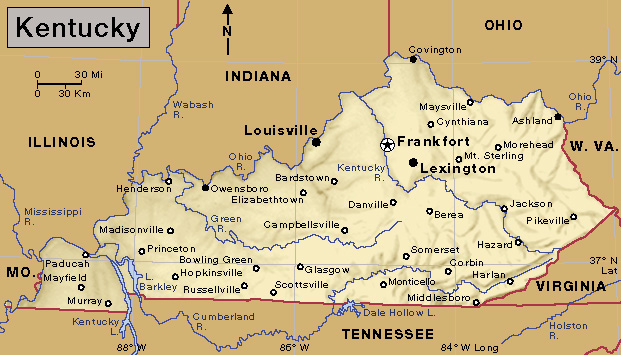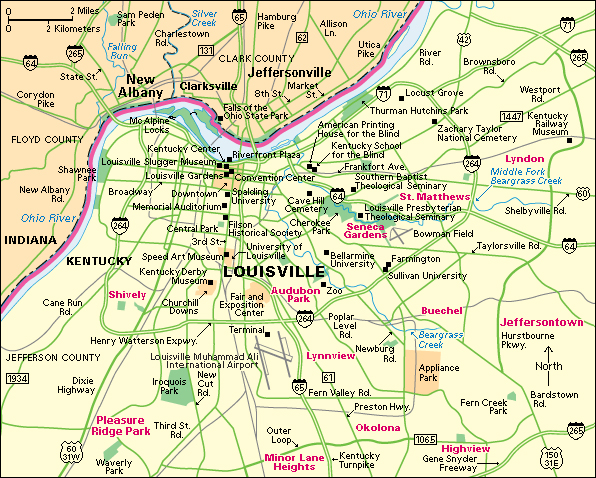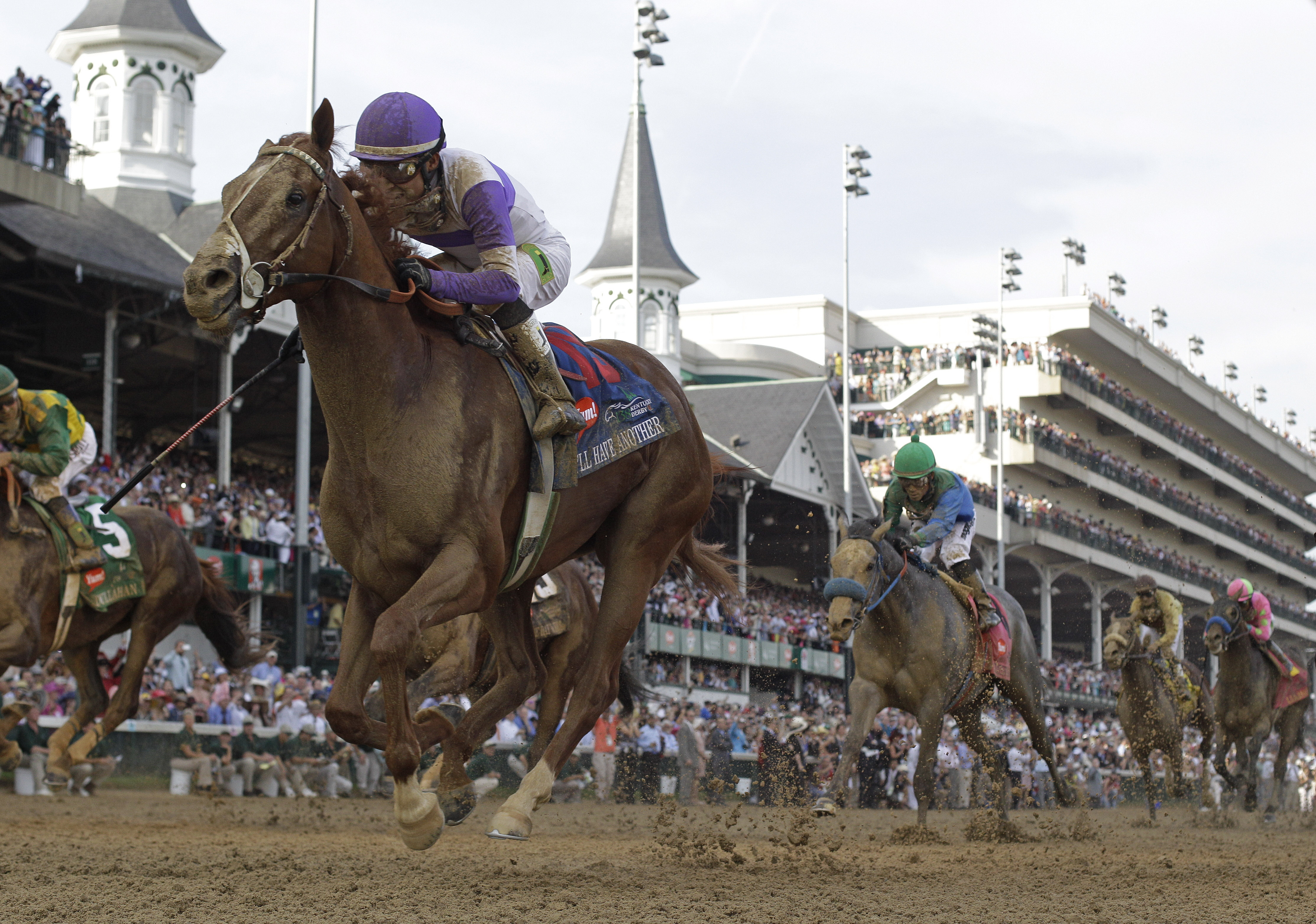Louisville, << LOO ee `vihl` or LOO ih `vuhl`, >> Kentucky, is an industrial and transportation center of the southeastern United States. Louisville lies on the Ohio River along the northern boundary of Kentucky. It grew up beside the falls of the river, and it is sometimes called the Falls City. In 2003, Louisville merged with Jefferson County and became the state’s largest city, officially called Louisville Metro.

The city is well known as the site of the Kentucky Derby, one of the most famous horse races in the world. The race is held at Churchill Downs in Louisville on the first Saturday in May.
In 1778, a group of pioneers led by the American explorer George Rogers Clark established a settlement on the site of what is now Louisville. The next year, the town was named for King Louis XVI of France in gratitude for France’s help to the American Colonies during the American Revolution (1775-1783).
River trade and the growth of railroads accounted for much of Louisville’s early development. After World War II ended in 1945, the city’s industry expanded rapidly. In the late 1900’s, as manufacturing declined, service industries became increasingly important.
The city.
In 2003, Louisville merged with Jefferson County, forming the Louisville/Jefferson County Metro Government. The Louisville metropolitan area spreads over all of Bullitt, Henry, Jefferson, Meade, Nelson, Oldham, Shelby, Spencer, and Trimble counties in Kentucky and over Clark, Floyd, Harrison, Scott, and Washington counties in Indiana. Low, rolling hills rise to the south and east of the city.

Louisville’s central business district consists mainly of an area 1 mile square (2.6 square kilometers), bordered by the Ohio River, 1st Street, 10th Street, and Broadway. Most of the city’s large banks, hotels, and office buildings are within this area. The district also includes city, county, and federal government buildings and a convention center. Riverfront Plaza, on the Ohio River between 4th and 6th streets, features statues of George Rogers Clark and of a black slave named York. York accompanied William Clark, George Rogers Clark’s brother, on the Lewis and Clark expedition, which explored the northwestern United States.
Three highway bridges and a railroad bridge cross the Ohio River and link Louisville with the Indiana cities of New Albany, Clarksville, and Jeffersonville. Freeways connect downtown Louisville with the surrounding area. The United States government keeps its gold reserve in huge vaults at Fort Knox, an Army base 30 miles (48 kilometers) south of downtown Louisville.
The people.
Almost all of Louisville’s people were born in the United States. The city’s population includes large groups of people of English, German, and Irish descent. African Americans make up about 25 percent of the population.
Economy.
The Louisville metropolitan area has thousands of factories. The major products include alcoholic beverages, automotive parts, chemicals, electric appliances, food products, motor vehicles, printed products, and sporting goods. The American Printing House for the Blind, the world’s largest publisher of products for people who are visually impaired, is in Louisville.

Wholesale and retail trade, health care, government, and other service industries employ many people in Louisville. The city is an important international air cargo shipping center. It is also a major river port. Towboats and barges link the city with other communities on the Ohio and Mississippi rivers. Freight railroads and dozens of truck lines also serve the Louisville area. Most commercial airliners use Louisville Muhammad Ali International Airport, and Bowman Field serves smaller planes. Louisville has one daily newspaper, The Courier-Journal.
Education.
The Jefferson County Board of Education governs the public schools in Louisville. The seven members of the board are elected to four-year terms. The Louisville area also has a number of parochial schools and other private schools.
Louisville has several colleges and universities. The University of Louisville was the first city-owned university in the United States. It was founded in 1798. The university operated under municipal control until 1970. That year, faced with rising costs, it became a state-supported school. Other institutions of higher learning include Bellarmine University, Louisville Presbyterian Theological Seminary, Southern Baptist Theological Seminary, and Spalding University. The Kentucky School for the Blind is also in Louisville.
The Louisville Free Public Library was one of the nation’s first public library systems. It was founded in 1816.
Cultural life.
The Louisville Orchestra, the Louisville Ballet, and the Kentucky Opera perform at the Kentucky Center for the Performing Arts in downtown Louisville. Stage One, a children’s theater, also presents performances at the Kentucky Center. Actors Theatre of Louisville is the home of the city’s resident professional theater company. The Kentucky Shakespeare Festival stages a series of plays each summer in Central Park. The Louisville Palace and the Brown Theatre, renovated theaters dating from the 1920’s, present live entertainment.
The Speed Art Museum stands on the University of Louisville campus. It exhibits traveling art shows in addition to its own collection.
A number of museums are on Main Street in downtown Louisville. The Kentucky Science Center features hands-on exhibits on science, math, and technology. The Kentucky Museum of Art and Craft presents the work of craft artists. The Frazier History Museum features historical weapons and armor. The Louisville Slugger Museum offers exhibits on baseball history and a tour of the factory where the famous Louisville Slugger baseball bats are made. The Muhammad Ali Center honors the famous American boxer, who was born in Louisville. It features interactive educational and cultural exhibits.
The Filson Historical Society, south of the downtown area, focuses on Kentucky history. The Kentucky Derby Museum at Churchill Downs features displays about horse racing. The Kentucky Railway Museum at nearby New Haven has a collection of steam locomotives and trolley and railroad cars from the 1800’s.
Recreation.
Louisville Waterfront Park, along the Ohio River, features walking paths, water sculptures, playgrounds, and a 12-acre (5-hectare) Great Lawn for outdoor concerts. David Armstrong Extreme Park has an outdoor surface for skateboarding, in-line skating, and biking. Iroquois Park includes a large amphitheater for summer musicals. The Kentucky Exposition Center is one of the largest exhibition centers in the United States. It includes an amusement park. Its coliseum hosts conventions, concerts, and sports events. The Louisville Zoo houses hundreds of animals, and it includes the Gorilla Forest, where visitors can view gorillas in their natural habitat.
Horse racing is one of the city’s most popular sports. Races are held in the spring and fall at Churchill Downs.

Louisville’s many historical attractions include Locust Grove, the home of George Rogers Clark, and Farmington, a house based on a design by Thomas Jefferson, the third president of the United States. Other historic places include Cave Hill Cemetery, where Clark is buried, and Zachary Taylor National Cemetery, the burial place of Taylor, the 12th president.
Government.
Louisville has a mayor-council government. Voters elect the mayor to a four-year term. The mayor may serve no more than three consecutive terms. The Louisville Metro Council has 26 members, elected to four-year terms. The government’s main sources of income are property taxes and occupational taxes, which are paid by people who work in the city.
The Louisville city government, like that of many other city governments, lacks home rule (self-government). Louisville must have the approval of the state legislature to act on many local matters.
History.
In 1778, the explorer George Rogers Clark led a group of pioneers from Pennsylvania down the Ohio River. After a brief stay on an island in the river, the pioneers established a settlement on the shore of the Ohio. The town was named Louisville in 1779. By 1800, about 350 people lived there.
Growth in the 1800’s.
Louisville’s location helped make the town an important river port and frontier community. The first oceangoing ship to reach Louisville arrived in 1800. In 1811, the New Orleans became the first steamship to dock there. Louisville received a city charter in 1828. The Portland Canal, completed in 1830, enabled ships to by-pass the falls of the river.
During the 1830’s and 1840’s, a large number of people moved to Louisville from the eastern United States and from Europe. They were attracted by the city’s economic opportunities, and they contributed greatly to Louisville’s political and cultural development.
Kentucky became a major tobacco-producing state during the 1830’s, and much tobacco processing took place in Louisville. By the 1840’s, the city ranked as one of the top tobacco centers in the world. By 1850, the population of Louisville had risen to more than 43,000. The growth of railroads during the 1850’s led to further growth for Louisville. By 1859, train service had begun between Louisville and Nashville, Tennessee.
During the American Civil War (1861-1865), both Union and Confederate sympathizers lived in Louisville. But Kentucky remained in the Union, and Louisville became a supply depot for Union troops. All trade was cut off with the South. A period of prosperity followed the war. Louisville business people regained their Southern markets, and railroads connected Louisville with Atlanta, New Orleans, and other Southern cities.
Since the opening of Louisville’s first race track in 1830, horse racing has been a leading sport in the city. Many of the horses have been raised in Kentucky’s famous bluegrass pastures. In 1874, a group of sportsmen founded the Louisville Jockey Club. Each of the 320 original members contributed $100. Colonel M. Lewis Clark, a horse breeder, used this money to build Churchill Downs. The first Kentucky Derby was held there in 1875.
Changes during the 1900’s.
By 1900, Louisville’s population had reached about 205,000. In 1937, the Ohio River overflowed its banks and swept through the city. The flood caused over $52 million in damage. A floodwall now protects the city.
During World War II (1939-1945), the United States government built three large ammunition plants in the Louisville area. Workers flocked to the city from rural communities to take factory jobs. The Army trained fliers at Bowman Field and infantrymen at Fort Knox. The increased defense activities helped raise the population to about 370,000 by 1950.
Peaceful desegregation of the public schools began in 1956, and all public accommodations were integrated in 1963. However, due to changing housing patterns and other factors, the schools became segregated again in the 1960’s. In 1975, a court-ordered busing program designed to desegregate local schools began in the Louisville area school district. Under the program, several thousand black children were bused from the city to suburban schools, and several thousand white children rode buses to schools in the central city. In 2000, a federal judge ended the court-ordered busing program. He said the racially separate system that had once made it necessary no longer existed.
The 1950’s, 1960’s, and 1970’s brought rapid physical changes to Louisville. A number of expressways were built. The city also began a major program to beautify downtown Louisville, including construction of public greens and fountains. In the early 1970’s, the downtown redevelopment led to construction of new office buildings and a second convention center. The University of Louisville opened a modern medical center with a large hospital. Private developers built a hotel and bank buildings along the waterfront.
During the late 1900’s, the city experienced a decline in manufacturing. Losses included the closings of two large cigarette plants; a major farm implements builder; and the Bourbon Stockyards, one of the country’s largest stockyards. Several distilleries also merged and closed. Thousands of workers in the appliance industry lost their jobs. However, growth in service industries helped offset the manufacturing losses. For example, the areas of health care, tourism, and finance expanded. In 1982, United Parcel Service (UPS) established a major cargo shipping center in Louisville.
Downtown redevelopment continued in the late 1900’s. The Presbyterian Church (U.S.A.) moved its national headquarters to downtown Louisville in 1988. The Humana Building, a Postmodern downtown building designed by the American architect Michael Graves, became a Louisville landmark. Louisville took steps to restore a large group of buildings with cast-iron facades along Main Street that date from the 1800’s. Efforts to reclaim the Ohio riverfront include the construction of a Great Lawn for performances and festivals.
The city’s population declined in the 1990’s, partly as a result of the loss of manufacturing jobs. But the population of the metropolitan area grew.
The early 2000’s.
In 2003, Louisville merged with Jefferson County. In 2020, the city had a population of 633,045.
